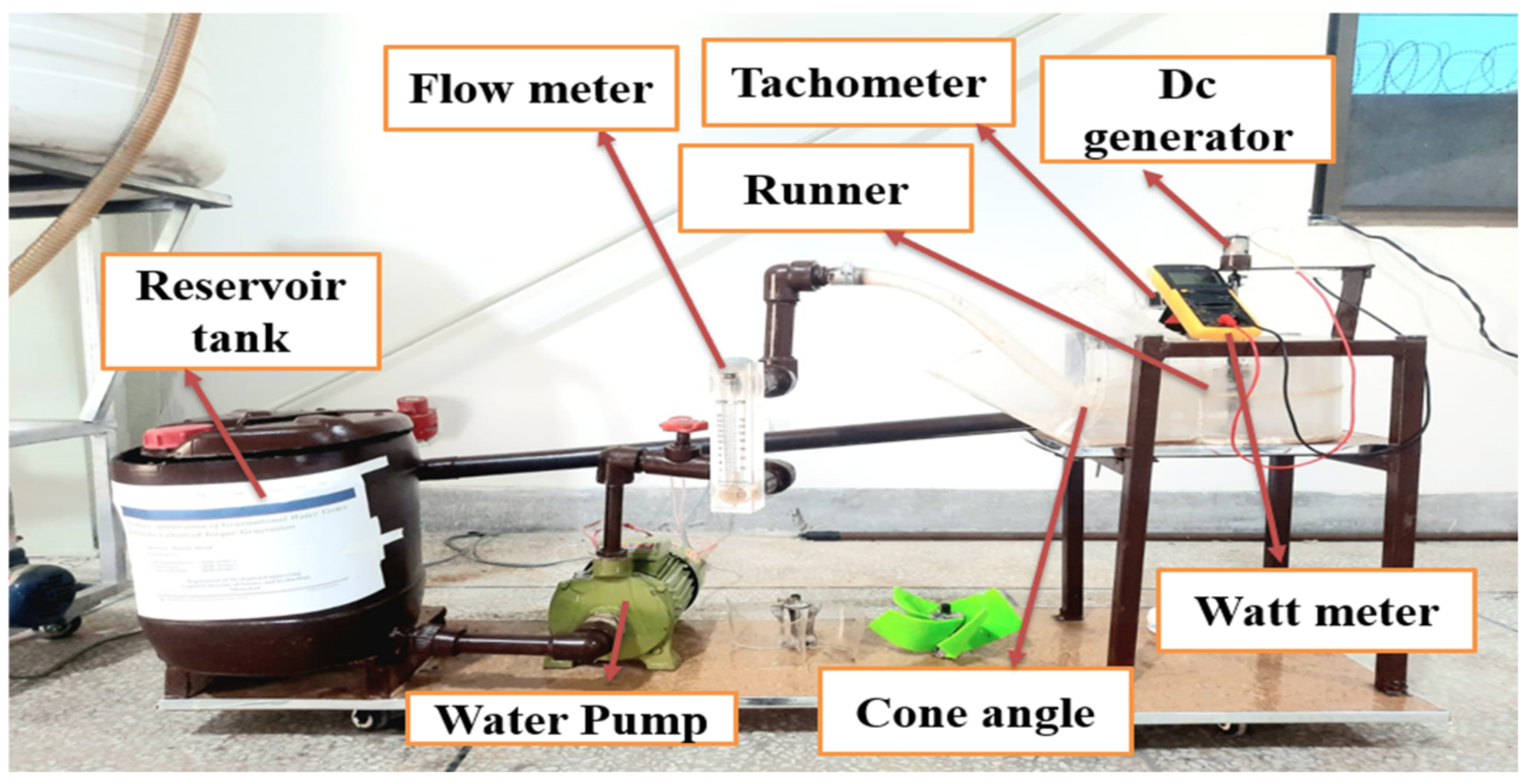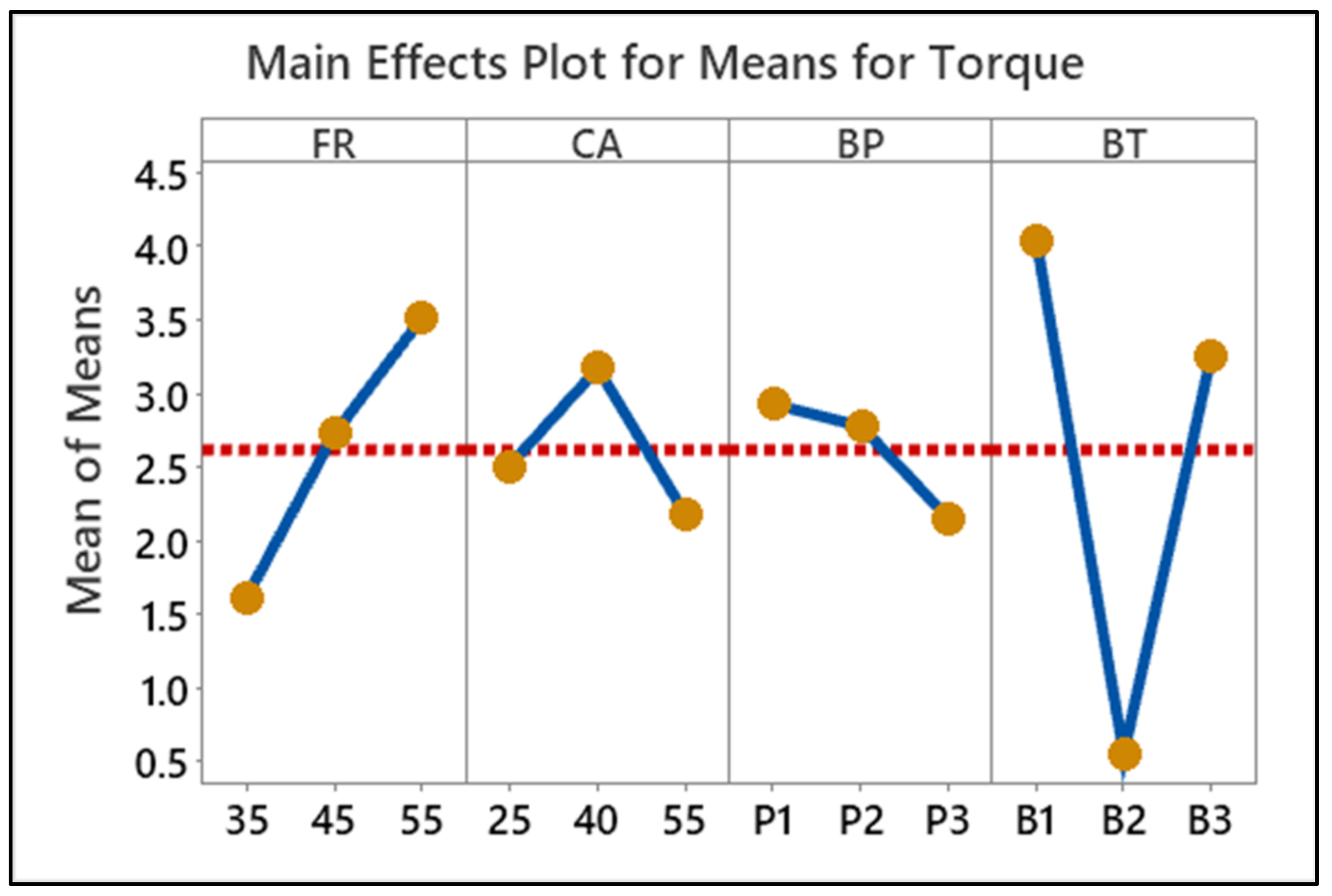Parametric Optimization of Gravitational Water Vortex Turbines for Enhanced Torque Generation †
Abstract
:1. Introduction
2. Methodology
2.1. Experimental Apparatus and Method
2.2. Design of Experiments
3. Results and Discussion
4. Conclusions
Author Contributions
Funding
Institutional Review Board Statement
Informed Consent Statement
Data Availability Statement
Conflicts of Interest
References
- Bajracharya, T.R.; Shakya, S.R.; Timilsina, A.B.; Dhakal, J.; Neupane, S.; Gautam, A.; Sapkota, A. Effects of Geometrical Parameters in Gravitational Water Vortex Turbines with Conical Basin. J. Renew. Energy 2020, 2020, 5373784. [Google Scholar] [CrossRef]
- Ullah, R.; Cheema, T.A. Experimental Investigation of Runner Design Parameters on the Performance of Vortex Turbine. Eng. Proc. 2022, 23, 14. [Google Scholar]
- Khan, T.; Asif, M.M.; Ahmed, H.; Islam, M.; Harun, Z. Design and Development of a Vortex Turbine for the Hilly Regions of Bangladesh. In Proceedings of the 2nd International Seminar of Science and Applied Technology (ISSAT 2021), Video Conference, 12 October 2021. [Google Scholar]
- Jha, A.K.; Subedi, D.U.; Timilsina, A.B. Assessment of Gravitational Water Vortex Hydropower Plant in Nepal. Int. Res. J. Eng. Technol. 2018, 5, 2679–2691. [Google Scholar]
- Nishi, Y.; Suzuo, R.; Sukemori, D.; Inagaki, T. Loss Analysis of Gravitation Vortex Type Water Turbine and Influence of Flow Rate on the Turbine’s Performance. Renew. Energy 2020, 155, 1103–1117. [Google Scholar] [CrossRef]


| Runs | Selected Factors | Response | Runs | Selected Factors | Response | ||||||
|---|---|---|---|---|---|---|---|---|---|---|---|
| Flow Rate (LPM) | Cone Angle (Degree) | Blade Position | Blade Type | Torque (Nm) | Flow Rate (LPM) | Cone Angle (Degree) | Blade Position | Blade Type | Torque (Nm) | ||
| 1 | 35 | 25 | P1 | B1 | 2.700 | 15 | 45 | 40 | P3 | B1 | 4.530 |
| 2 | 35 | 25 | P1 | B1 | 3.220 | 16 | 45 | 55 | P1 | B2 | 0.440 |
| 3 | 35 | 25 | P1 | B1 | 3.805 | 17 | 45 | 55 | P1 | B2 | 0.527 |
| 4 | 35 | 40 | P2 | B2 | 0.230 | 18 | 45 | 55 | P1 | B2 | 0.623 |
| 5 | 35 | 40 | P2 | B2 | 0.260 | 19 | 55 | 25 | P3 | B2 | 0.836 |
| 6 | 35 | 40 | P2 | B2 | 0.332 | 20 | 55 | 25 | P3 | B2 | 0.681 |
| 7 | 35 | 55 | P3 | B3 | 1.420 | 21 | 55 | 25 | P3 | B2 | 1.101 |
| 8 | 35 | 55 | P3 | B3 | 1.300 | 22 | 55 | 40 | P1 | B3 | 4.698 |
| 9 | 35 | 55 | P3 | B3 | 1.316 | 23 | 55 | 40 | P1 | B3 | 5.159 |
| 10 | 45 | 25 | P2 | B3 | 2.626 | 24 | 55 | 40 | P1 | B3 | 5.144 |
| 11 | 45 | 25 | P2 | B3 | 4.048 | 25 | 55 | 55 | P2 | B1 | 4.210 |
| 12 | 45 | 25 | P2 | B3 | 3.550 | 26 | 55 | 55 | P2 | B1 | 4.560 |
| 13 | 45 | 10 | P3 | B1 | 3.899 | 27 | 55 | 55 | P2 | B1 | 5.160 |
| 14 | 45 | 10 | P3 | B1 | 4.270 | ||||||
| Level | Flow Rate | Cone Angle | Blade Position | Blade Type |
|---|---|---|---|---|
| 1 | 1.6203 | 2.5074 | 2.9241 | 4.0393 |
| 2 | 2.7237 | 3.1691 | 2.7751 | 0.5590 |
| 3 | 3.5054 | 2.1730 | 2.1503 | 3.2512 |
| Delta | 1.8851 | 0.9962 | 0.7737 | 3.4804 |
| Rank | 2 | 3 | 4 | 1 |
Disclaimer/Publisher’s Note: The statements, opinions and data contained in all publications are solely those of the individual author(s) and contributor(s) and not of MDPI and/or the editor(s). MDPI and/or the editor(s) disclaim responsibility for any injury to people or property resulting from any ideas, methods, instructions or products referred to in the content. |
© 2023 by the authors. Licensee MDPI, Basel, Switzerland. This article is an open access article distributed under the terms and conditions of the Creative Commons Attribution (CC BY) license (https://creativecommons.org/licenses/by/4.0/).
Share and Cite
Mobeen, M.; Jaweed, S.; Abdullah, A.; Rasheed, S.; Masud, M. Parametric Optimization of Gravitational Water Vortex Turbines for Enhanced Torque Generation. Eng. Proc. 2023, 45, 3. https://doi.org/10.3390/engproc2023045003
Mobeen M, Jaweed S, Abdullah A, Rasheed S, Masud M. Parametric Optimization of Gravitational Water Vortex Turbines for Enhanced Torque Generation. Engineering Proceedings. 2023; 45(1):3. https://doi.org/10.3390/engproc2023045003
Chicago/Turabian StyleMobeen, Muhammad, Saqib Jaweed, Ahmad Abdullah, Shummaila Rasheed, and Manzar Masud. 2023. "Parametric Optimization of Gravitational Water Vortex Turbines for Enhanced Torque Generation" Engineering Proceedings 45, no. 1: 3. https://doi.org/10.3390/engproc2023045003
APA StyleMobeen, M., Jaweed, S., Abdullah, A., Rasheed, S., & Masud, M. (2023). Parametric Optimization of Gravitational Water Vortex Turbines for Enhanced Torque Generation. Engineering Proceedings, 45(1), 3. https://doi.org/10.3390/engproc2023045003






